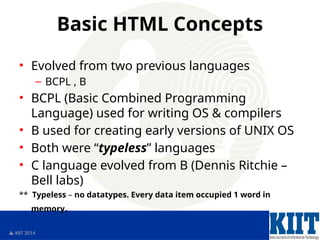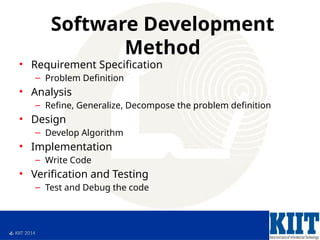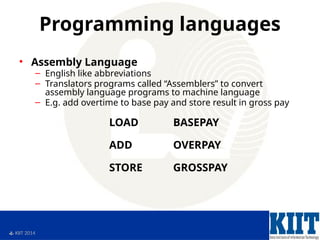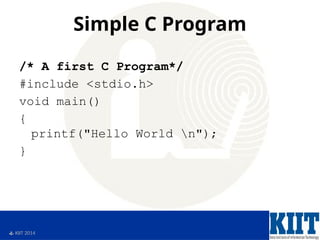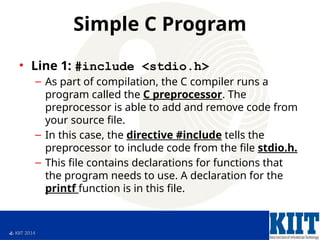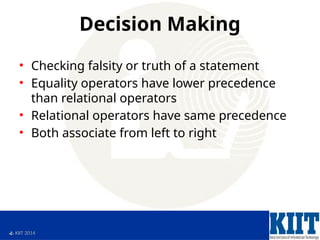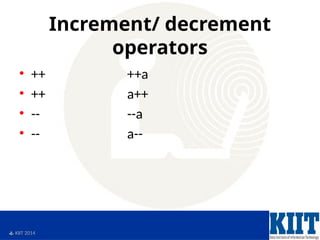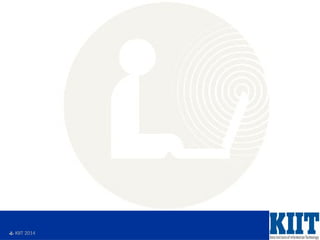Introduction to Web development & HTML Programming
- 1. KIIT 2014 1 HTML Programming
- 2. KIIT 2014 Objectives After completing this lesson, you should be able to do the following: • Introduction • History of HTML • Basic HTML Concepts • Creating HTML Document in Text Editor • Networking Topologies • Define Node in the Network • Use of Internet and WEB • Define DNS
- 3. KIIT 2014 Introduction • Hypertext Markup Language(HTML) is a major language of the Internet’s World Wide Web. • Hypertext is an ordinary text that has some extra features such as formatting. Images, multimedia, and links to another document. • Markup is the process of adding extra features to ordinary text. • Language means that it has its own syntax, jargon and rules for proper communication
- 4. KIIT 2014 History of HTML • In 1989, Tim Berners-Lee, a computer scientist at CERN (the European Organization for Nuclear Research) developed HTML. • HTML developed in the following four stages: – Level 0 – Level 1 – Level 2 – Level 3
- 5. KIIT 2014 Evolution Year Version 1989 Tim Berners-Lee invented www 1991 Tim Berners-Lee invented HTML 1993 Dave Raggett drafted HTML+ 1995 HTML Working Group defined HTML 2.0 1997 W3C Recommendation: HTML 3.2 1999 W3C Recommendation: HTML 4.01 2000 W3C Recommendation: XHTML 1.0 2008 WHATWG HTML5 First Public Draft 2012 WHATWG HTML5 Living Standard 2014 W3C Recommendation: HTML5 2016 W3C Candidate Recommendation: HTML 5.1 2017 W3C Recommendation: HTML5.1 2nd Edition 2017 W3C Recommendation: HTML5.2
- 6. KIIT 2014 Basic HTML Concepts • Evolved from two previous languages – BCPL , B • BCPL (Basic Combined Programming Language) used for writing OS & compilers • B used for creating early versions of UNIX OS • Both were “typeless” languages • C language evolved from B (Dennis Ritchie – Bell labs) ** Typeless – no datatypes. Every data item occupied 1 word in memory.
- 7. KIIT 2014 History of C • In 1972 Dennis Ritchie at Bell Labs writes C and in 1978 the publication of The C Programming Language by Kernighan & Ritchie caused a revolution in the computing world • In 1983, the American National Standards Institute (ANSI) established a committee to provide a modern, comprehensive definition of C. The resulting definition, the ANSI standard, or "ANSI C", was completed late 1988.
- 8. KIIT 2014 Capabilities of C • Low Level Language Features • Portability • Powerful • Bit Manipulation • High Level Language Features • Modular Programming • Efficient use of Pointers
- 9. KIIT 2014 Software Development Method • Requirement Specification – Problem Definition • Analysis – Refine, Generalize, Decompose the problem definition • Design – Develop Algorithm • Implementation – Write Code • Verification and Testing – Test and Debug the code
- 10. KIIT 2014 Development with C • Four stages – Editing: Writing the source code by using some IDE or editor – Preprocessing or libraries: Already available routines – Compiling: translates or converts source to object code for a specific platform source code -> object code – Linking: resolves external references and produces the executable module • Portable programs will run on any machine Note: Program correctness and robustness are most important than program efficiency
- 11. KIIT 2014 Programming languages • Various programming languages • Some understandable directly by computers • Others require “translation” steps – Machine language • Natural language of a particular computer • Consists of strings of numbers(1s, 0s) • Instruct computer to perform elementary operations one at a time • Machine dependant
- 12. KIIT 2014 Programming languages • Assembly Language – English like abbreviations – Translators programs called “Assemblers” to convert assembly language programs to machine language – E.g. add overtime to base pay and store result in gross pay LOAD BASEPAY ADD OVERPAY STORE GROSSPAY
- 13. KIIT 2014 Programming languages • High-level languages – To speed up programming even further – Single statements for accomplishing substantial tasks – Translator programs called “Compilers” to convert high-level programs into machine language – E.g. add overtime to base pay and store result in gross pay grossPay = basePay + overtimePay
- 14. KIIT 2014 C Standard Library • Two parts to learning the “C” world – Learn C itself – Take advantage of rich collection of existing functions called C Standard Library • Avoid reinventing the wheel • SW reusability
- 15. KIIT 2014 Basics of C Environment • C systems consist of 3 parts – Environment – Language – C Standard Library • Development environment has 6 phases – Edit – Pre-processor – Compile – Link – Load – Execute
- 16. KIIT 2014 Basics of C Environment Editor Disk Phase 1 Program edited in Editor and stored on disk Preprocessor Disk Phase 2 Preprocessor program processes the code Compiler Disk Phase 3 Creates object code and stores on disk Linker Disk Phase 4 Links object code with libraries and stores on disk
- 17. KIIT 2014 Basics of C Environment Loader Phase 5 Puts program in memory Primary memory CPU Phase 6 Takes each instruction and executes it storing new data values Primary memory
- 18. KIIT 2014 C Program Example A C program basically consists of the following parts: • Preprocessor Commands • Functions • Variables • Statements & Expressions • Comments
- 19. KIIT 2014
- 20. KIIT 2014 Simple C Program /* A first C Program*/ #include <stdio.h> void main() { printf("Hello World n"); }
- 21. KIIT 2014 Simple C Program • Line 1: #include <stdio.h> – As part of compilation, the C compiler runs a program called the C preprocessor. The preprocessor is able to add and remove code from your source file. – In this case, the directive #include tells the preprocessor to include code from the file stdio.h. – This file contains declarations for functions that the program needs to use. A declaration for the printf function is in this file.
- 22. KIIT 2014 Simple C Program • Line 2: void main() – This statement declares the main function. – A ‘C’ program can contain many functions but must always have one main function. – A function is a self-contained module of code that can accomplish some task. – Functions are examined later. – The "void" specifies the return type of main. In this case, nothing is returned to the operating system.
- 23. KIIT 2014 Simple C Program • Line 3: { – This opening bracket denotes the start of the program.
- 24. KIIT 2014 Simple C Program • Line 4: printf("Hello World n"); – printf is a function from a standard C library that is used to print strings to the standard output, normally your screen. – The compiler links code from these standard libraries to the code you have written to produce the final executable. – The "n" is a special format modifier that tells the printf to put a line feed at the end of the line. – If there were another printf in this program, its string would print on the next line.
- 25. KIIT 2014 Simple C Program • Line 5: } – This closing bracket denotes the end of the program.
- 26. KIIT 2014 Compile & Execute C Program Following are the simple steps: • Open a text editor and add the above-mentioned code. • Save the file as hello.c • Open a command prompt and go to the directory where you saved the file. • Type gcc hello.c and press enter to compile your code. • If there are no errors in your code, the command prompt will take you to the next line and would generate a.out executable file. • Now, type a.out to execute your prog ram. • You will be able to see "Hello World" printed on the screen
- 27. KIIT 2014 Summary In this lesson, you should have learned how to: • Define C language • List the capabilities of C language • Define Software Development Method • Develop software with C • Write programs in different types of Languages • Write Simple C Program • Compile & Execute C Program
- 28. KIIT 2014 Escape Sequence • n new line • t tab • r carriage return • a alert • backslash • ” double quote
- 29. KIIT 2014 Memory concepts • Every variable has a name, type and value • Variable names correspond to locations in computer memory • New value over-writes the previous value– “Destructive read-in” • Value reading called “Non-destructive read- out”
- 30. KIIT 2014 Arithmetic in C C operation Algebric C Addition(+) f+7 f+7 Subtraction (-) p-c p-c Multiplication(*) bm b*m Division(/) x/y, x , x y x/y Modulus(%) r mod s r%s
- 31. KIIT 2014 Precedence order • Highest to lowest – () – *, /, % – +, -
- 32. KIIT 2014 Example Algebra: z = pr%q+w/x-y C: z = p * r % q + w / x – y ; Precedence: 1 2 4 3 5
- 33. KIIT 2014 Example Algebra: a(b+c)+ c(d+e) C: a * ( b + c ) + c * ( d + e ) ; Precedence: 3 1 5 4 2
- 34. KIIT 2014 Decision Making • Checking falsity or truth of a statement • Equality operators have lower precedence than relational operators • Relational operators have same precedence • Both associate from left to right
- 35. KIIT 2014 Decision Making • Equality operators – == – != • Relational operators – < – > – <= – >=
- 36. KIIT 2014 Summary of precedence order Operator Associativity () left to right * / % left to right + - left to right < <= > >= left to right == != left to right = left to right
- 37. KIIT 2014 Assignment operators • = • += • -= • *= • /= • %=
- 38. KIIT 2014 Increment/ decrement operators • ++ ++a • ++ a++ • -- --a • -- a--
- 39. KIIT 2014 Increment/ decrement operators main() { int c; c = 5; printf(“%dn”, c); printf(“%dn”, c++); printf(“%dnn”, c); c = 5; printf(“%dn”, c); printf(“%dn”, ++c); printf(“%dn”, c); return 0; }
- 40. KIIT 2014






